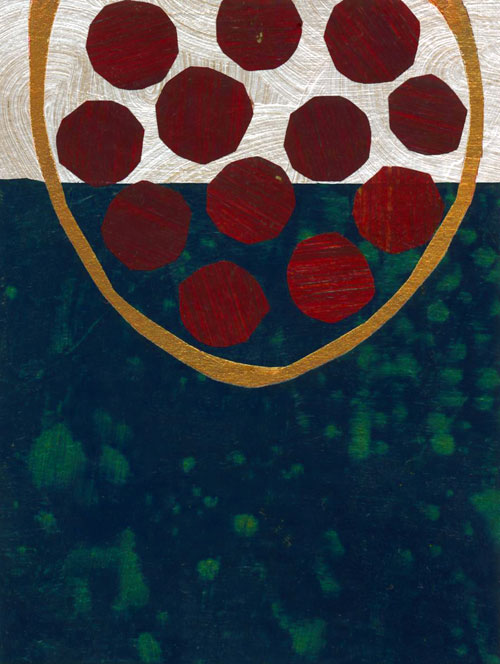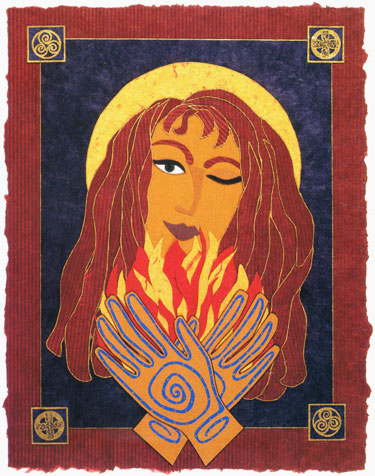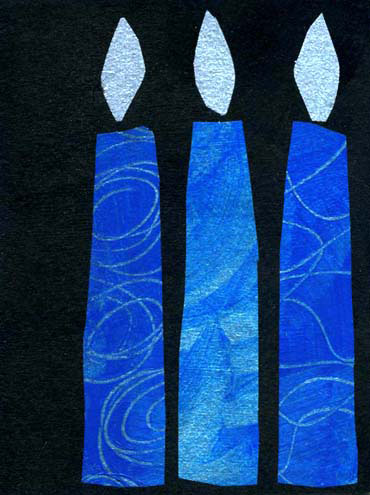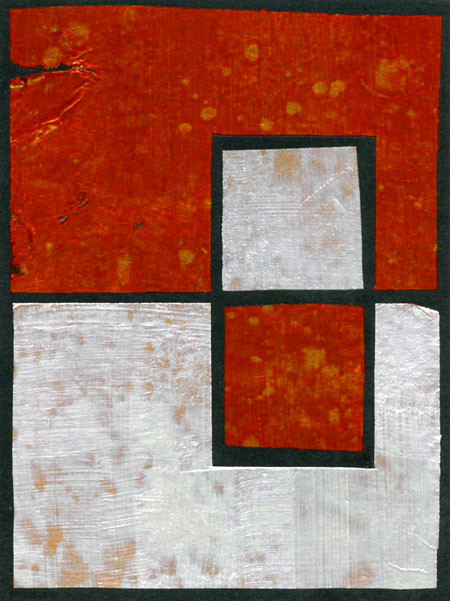
The Willing Catch © Jan L. Richardson
Reading from the Gospels, Epiphany 5, Year C (Feb. 7): Luke 5.1-11
As I write this, I’m winging my way toward Minnesota, where my sweetheart and I will be leading several events over the next few days. With a few generations of Florida blood running through my veins, I’m questioning the sanity of going to Minnesota at this time of year. (“Are you crazy?” one of my Minnesota friends asked upon hearing I was heading his way). The timing of the trip, however, was determined by the sanctoral calendar: one of the events that Gary and I will be leading is a celebration of St. Brigid, whose feast day is February 1. While the prospect of spending several days in below-freezing temperatures has me wishing that Brigid’s day fell in midsummer, I’m thrilled by the opportunity to celebrate her feast in the company of friends, both longtime ones and those yet to be made.
I have long been intrigued by and devoted to this Irish saint who has been beloved in her homeland and beyond for more than a millennia and a half. Born in the middle of the fifth century, Brigid became a formidable leader who helped to shape the landscape of Irish Christianity when it was still relatively new to the island. She traveled widely in her ministry and established a number of monasteries, the most famous one being the double monastery (comprised of women and men) at Cill Dara (“The Church of the Oak”), now known as Kildare.
Brigid was renowned for her hospitality and generosity. In her biography of the saint, Alice Curtayne describes how Brigid found the poor “irresistible” and ministered to them with “a habit of the wildest bounty.” Accounts of Brigid’s life are replete with stories of how, in places of lack, Brigid’s actions help to bring forth abundance, whether of food or drink or healing or justice. In these accounts, Brigid is a worker of wonders; her miracles echo the miracles of Christ and draw upon the same power by which he provided for those in need. She reminds us of the ways that God is so often profligate toward us: how God, out of sheer, inexplicable delight and love for us, provides for us in ways that have the power to stun us.
Though she was known for not turning anyone away (“Every guest is Christ,” Brigid said), Brigid nonetheless brought a spirit of discernment to her generosity: she knew that miracles don’t always look like we expect them to look, and they often require something of us beyond what we had anticipated. The Irish Life of St. Brigid relates that one day, a man with leprosy approaches St. Brigid and says, “For God’s sake, Brigit, give me a cow.” With the air of someone who has perhaps been approached by the man a number of times before, Brigid tells him to leave her alone. He persists. Brigid asks him how it would be if they prayed to God for the removal of the man’s leprosy. “No,” he replies, “I get more this way than if I were clean.” Brigid disagrees with his priorities and insists that he “take a blessing and be cleansed.” The man acquiesces, acknowledging that he is in much pain. Upon receiving his cure, the man vows his devotion to Brigid, pledging to be her servant and woodman.
I’m quite enjoying the fact that in the same week that we are celebrating Brigid’s feast, the lectionary gives us this passage from Luke. Put out into the deep water, Jesus says to Simon, and let down your nets for a catch. Simon tells him what Jesus already likely knows: Master, we have worked all night long but have caught nothing. Yet if you say so, I will let down the nets. And what comes up sends Simon to his knees: net-breaking, boat-sinking abundance. In the place where Simon and his fellow fishermen had already been laboring, in the landscape they thought they knew, in the place where they had come up empty: a stunning catch, lavish beyond measure.
Fish weren’t the only catch of the day; Simon and his companions were hooked. Captivated. Called. And that’s what miracles are meant to do: they meet us at our point of need, but they do not leave us there. They call us to move from being recipients to being participants, to share in the ways that God pours out Godself for the life of the community and the healing of the world.
In this week, Luke’s fish tale and the feast of St. Brigid have me wondering, what do I really believe about the ways that God works in this world? Have I grown fixed in my expectations about what God is up to? Do I have eyes to see the surprising ways in which God moves in the midst of situations whose outcome I think I already know? Is there deep water I need to put my net into—beyond what I can see, beyond what I know, beyond my familiar limits—to bring up an abundance that God has in store? What am I willing to leave behind in order to participate in such a miracle and to pass it along to others? What habits of wildest bounty might God be inviting me to practice?
In these coming days, may you participate and pass along the wildest bounty of God. Blessings!
P.S. As Brigid’s feast day approaches, I invite you to visit a reflection I wrote for her feast day last year:

Feast of St. Brigid: A Habit of the Wildest Bounty
This is a doubly festive week: the Feast of the Presentation, also called Candlemas, falls the day after Brigid’s feast. For an earlier reflection on this feast day, please click below:

Feast of the Presentation/Candlemas
[The image “The Willing Catch” is from the reflection Hooked. To use this image, please visit this page at janrichardsonimages.com. Your use of janrichardsonimages.com helps make the ministry of The Painted Prayerbook possible. Thank you!]
















